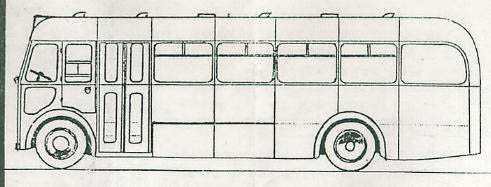Back To My Routes
Firstly, if you've come straight to this page from off-site, please read this for an explanation.
D13: Wrexham - Tanyfron
Back in the times that I'm talking about on this page - that is, the end of the 1960s and the beginning of the seventies - Tanyfron had a bus service all to itself. It ran on the same route as the D15 (q.v.) up to by the Rollers Arms in Southsea before turning left up to Tanyfron.
Now I can't vouch for certain for the route which it took after it got up there; after all, I would never have used that service at that time. However, I think it's reasonable to assume that once it had got to the top of College Hill, it would have turned left and then gone anti-clockwise around Bryn Gwenfro, St Alban's View and Cae Merfyn before going along the southern end of Park Road and down past the school on the way back to town (*). Certainly, the presence of quite old-looking bus stops on that section of the route would suggest this, although I concede that it is perfectly possible that the service simply turned at the top end of Park Road and kept on going down. This would have been much easier in those days because far fewer people had cars, and so bus drivers were not faced with trying to play Trik-Trak with parked vehicles. This did not stop Arriva from attempting a couple of years or so ago to send their vehicles along the full length of Park Road (which gets narrower as it goes up), with the inevitable consequences of seriously-delayed buses and the odd lost mirror. They soon thought better of it.
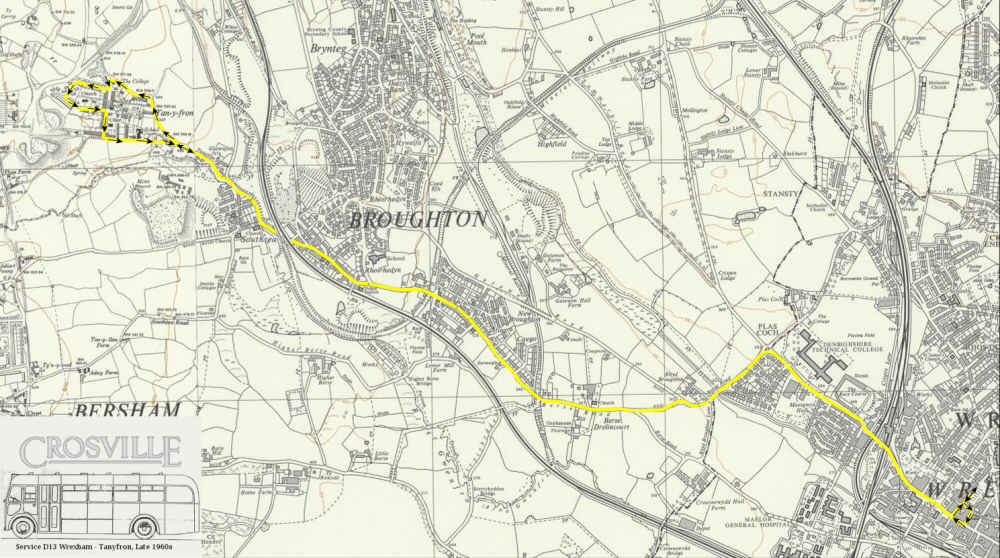
The Tanyfron-only D13 service was withdrawn sometime around 1973 and from then on the village was served by a new D14 service which went around Tanyfron before going up through Lodge to Brymbo. The 14 route today (the 'D' and other prefixes were dropped in, I think, the late 1980s) now goes around Tanyfron then up along Phoenix Drive to Brymbo, missing Lodge out altogether.
Thighnote (because it's too far up the page to be a footnote): I've since had confirmation from my friend and one-time colleague Carl that the D13 did indeed go that way.
D15: Wrexham - Brymbo
It was the coming of regular bus services between Wrexham and Brymbo which killed off the rail services between them, the passenger trains ceasing operation at the beginning of 1931. From then on, Crosville gained a monopoly on the route which they were to maintain until the Great Deregulation of 1986.
The D15 service ran - like the D13, D16 and D19 (qq.v.) (but not the D17 - see that section below) - out along Mold Road. Then it turned left up through Caego and New Broughton to Southsea, through Lodge and up through the old Brymbo village to the Penygraig estate, going along Penygraig Road to the terminus at the northern end of Ffordd Owain before going south down that road, right onto the bottom end of Argoed before rejoining Penygraig Road and heading back to town. This - as with the D13 - avoided the need for the reversing turnarounds which were a feature of the D17 and D19 services.

As the 1970s progressed (if that's the right word) and services were 'rationalised' (that is to say, 'cut'), the services to Brymbo changed. Not only - as described above - was there now a D14 which ran via Tanyfron, but there was also a new D13 service running every other with the D15. This followed the D15 route up to the Penygraig estate, but went past the southern end of Penygraig Road to take the next right up Edwards Avenue - which was now connected to Pool Road by a proper road rather than the rutted track which had previously existed - then on down Dyke Street and Offa Street to Penygraig Road and the terminus.
(Note that Edwards Avenue itself didn't even exist at the time of this map, let alone a track, rutted or otherwise).
One restriction still applied, however. It was called Tai Bridge, and the fact that it was, a) an arched bridge, and b) on a sharp bend, meant that we never saw double-decker buses on any of the routes, even though passenger numbers would have warranted their use (certainly more so than the D19, about which more anon). It wasn't until after deregulation, when an alternative service was provided by Wrights of Wrexham (note missing possessive apostrophe) which ran via Brynteg and Pentre Broughton - thereby avoiding Tai Bridge altogether - that we saw double-deckers up here on a regular basis.
(And it could be pretty hairy coming down the narrow and twisting Station Road from Pentre Broughton and on to the edge-of-the-slope Queens Road whilst sitting upstairs at the front of the bus).
Wrights went out of business in 1993 and Crosville - as it still was at that time - then switched its own Brymbo service to use the same route used by its vanished competitor, and the 12/12A still runs that way today, with variations at the Wrexham end (the 12 operates via Wrexham Maelor Hospital, the 12A via Plas Coch Retail Park and Mold Road).
D16: Wrexham - Treuddyn
This always seemed to me to be rather an odd route to run. It may well have been that once the section of passenger railway from Brymbo to Mold closed in March 1950, the need was felt for a bus service running more or less parallel to the old line.
(There may be a parallel of another sort in that, when the Ruabon - Barmouth railway line was closed in 1965, a replacement bus service (numbered D94) was established. This is why that route - since renumbered first to '94' and latterly to 'T3' as part of the TrawsCymru network - goes the back way from Corwen to Bala rather than along the A5/A494 main roads).
Whether that was the thinking in this case or not, the D16 service ran along the same route as the D15 up to Coedyfelin Road in Brymbo before continuing down past St Mary's Church to the B5102 Minera road and then on through Ffrith and Llanfynydd to Treuddyn. I've no idea whether it ran a circular route around that village or did a turnaround; I suspect the latter. The route disappears off the north end of my map in any case. And of course - for the same reason as the D15 - no double-deckers ever ran on the route.
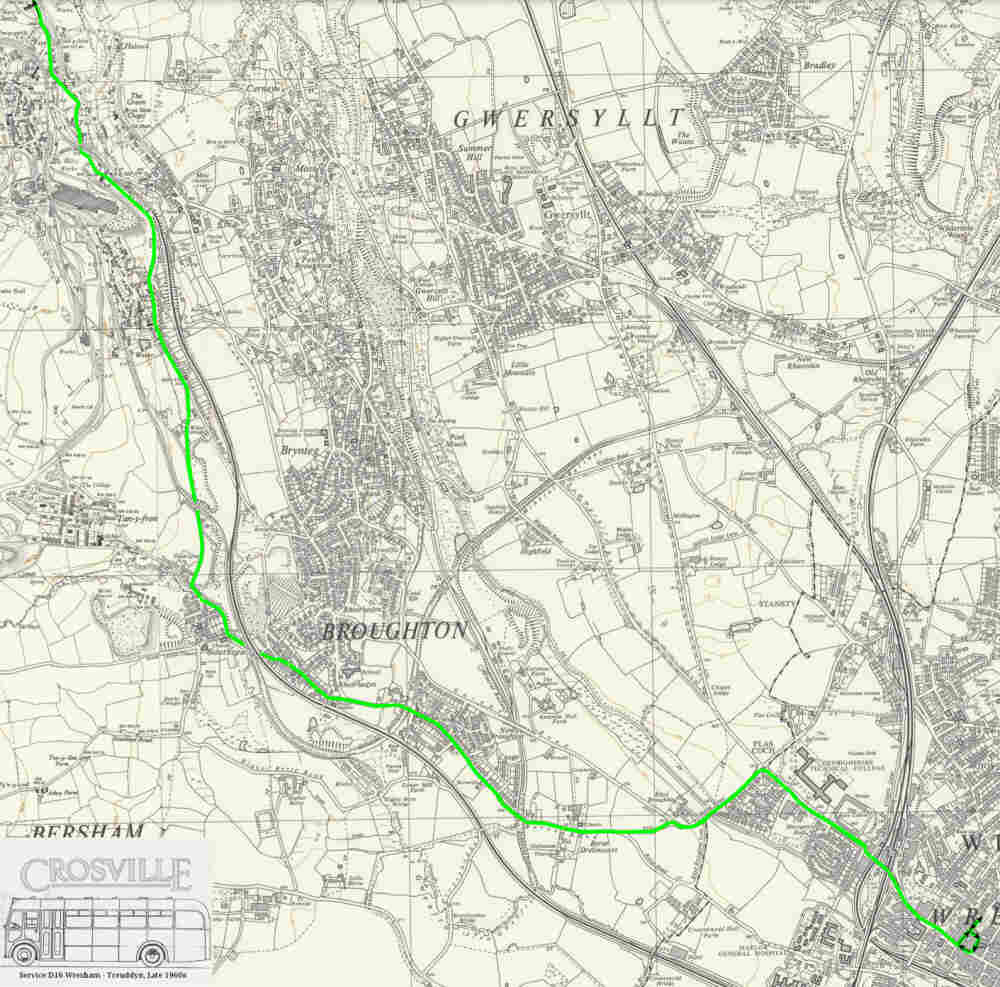
The D16 was withdrawn in the early 1970s and - after a variety of changes and shake-ups - Treuddyn is no longer accessible directly by bus from Wrexham, having only a limited service from Mold to Hope which takes in not only Treuddyn but Ffrith and Cymau.
Being nerdy before my time, I used to annoy my mother by suggesting that - instead of taking the D15 home from town or from my grandmother's home in New Broughton - we took the D16 instead. This meant having to walk home from The Plantation, which was not only over half a mile but was almost entirely uphill. My requests were seldom viewed favourably.
D17: Wrexham - Moss
As you will see from the map below, the D17 route was different in one key respect from all the others I'm covering here.
Back in those days, the route out of Wrexham going by what was then called Maelor General Hospital was - once you got past the little bridge over the River/Open Sewer Gwenfro - little more than a country lane winding through farmland. So, in an age where the vehicles were wider, longer and heavier than today, almost all bus services heading westwards out of Wrexham used the Mold Road coming out of the town centre.
The D17 was the only service which turned left off Regent Street in town to go along Bradley Road and then right onto Watery Road and past the Hospital.
But there was another twist to the route as well, and one which caused me a problem when I thought about doing this page (as I explained in the item which links to this one). Once it got beyond Croesnewydd Hall Farm, the bus would not do the obvious thing and turn right down Rhyd Broughton Lane to join up with Berse Road and share that part of the route with Ds 13, 15, 16 and 19. Instead, it kept straight on to a section of road which ceased to exist in about 1972 when the Wrexham By-Pass was constructed, and rejoined Berse Road just east of Berse Drelincourt Church.
And if that were not enough, there was another quirk (and one which had its equivalent on the D19 route, as you'll see); namely that the service followed a slightly different route outbound from the inbound one.
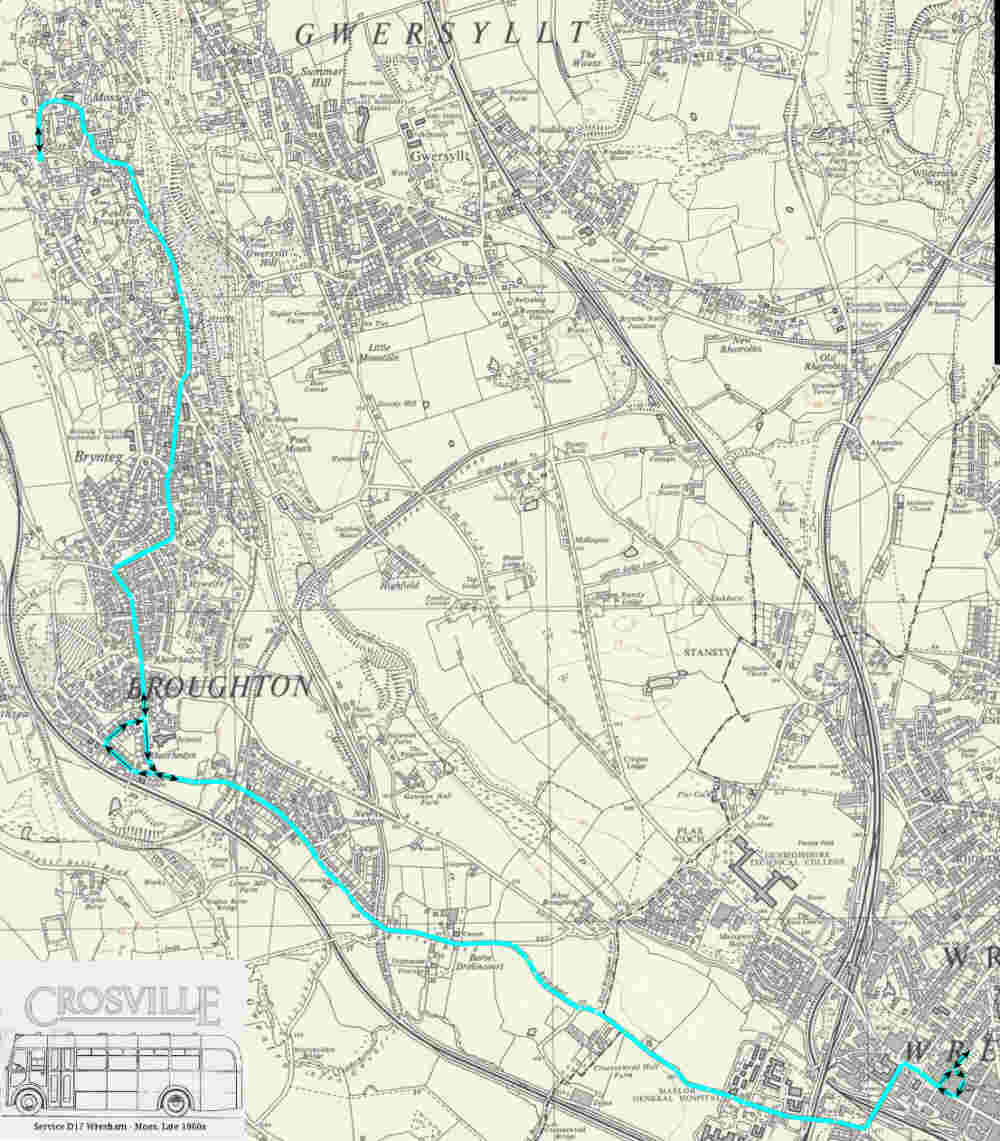
If you look at the western side of the map, you will see that, outbound, the route travelled along Wrexham Road in Southsea to a point just before the Post Office before turning right up Cross Street and then turning left up Bryn Hedd. Inbound, the bus would come down Bryn Hedd and then keep on going down Bryn Rhedyn before joining up with Wrexham Road again.
The outbound route then climbed to Brynteg and went along Darby Road and Victoria Road before crossing the bottom of Castle Hill (or, to give it its formal name, Hill Street) by the Castle Inn and heading off down Westminster Road towards Moss.
(The question of where one village ends and another begins in this area is a complex one. Southsea and Brynteg arm-wrestle with one another; Darby Road is in the latter whilst Bryn Goleu which leads off it to the south is in the former. Likewise, although the Castle Inn was always deemed to be in Moss, Hill Street at the bottom of which it stood was considered to be in Pentre Broughton. This leads to the bizarre situation of Brynteg Post Office - halfway up Hill Street - being located in the next village).
After travelling along Westminster Road for much of its length, the route then runs off to the left and up into Castletown, more or less bypassing the bottom end of Moss altogether (which was served by a bus operated by Chaloner's of Moss , and ran via Wheatsheaf Lane in Gwersyllt). Castletown Road was a potential tight spot, with one house on the bend right on the road's edge, which - thanks to a combination of the road being narrow and buses being of such dimensions in those days - meant that the poor sod who lived there had his guttering knocked off two or three times a year.
The bus would then run up the hill beyond Brake Chapel to Gwalia Road (which is in Pentre Broughton; another anomaly) before turning around. I'm not sure at this distance whether the bus would turn around behind George Pugh's hardware shop at the end of a road which was blocked off at the western end sometime in the early 1980s or whether it continued on a couple of dozen yards further to turn around behind the site of the former Palace Cinema (†). Either way, turn around it did before heading back to Wrexham.
During all the faffing about either side of deregulation, the route of the D17 changed substantially. As the buses to Brymbo were now going via Brynteg and Pentre Broughton, the need for another service through those villages was no longer there, so the D17 - still coming out of town via the Hospital, but now on a road massively upgraded due to the westward expansion of that institution - now turned off Berse Road and travelled up Gatewen Road and along the bottom of Coed Efa in New Broughton (replacing the D19 service along that stretch) before climbing to the Castle Inn and reverting to the old route. Once at Gwalia Road however, it would continue on via Clayton Road (see D19 below) and into Brymbo before returning to Wrexham via Lodge (which had also been orphaned by the changes on the Brymbo route). The service passed back and to between Crosville and a number of independent operators, and the present sorry state of the 17 is that it now misses out all bar the very bottom part of Brymbo, and runs only three times a day on just three days a week.
Shin-note (i.e., lower than the thighnote but still not far enough down to be a footnote): I now have confirmation that it turned around behind George Pugh's.
D19: Wrexham - Pentre Broughton
The last bus service I will cover in this piece ran out of Wrexham in the same way as the others apart from the D17; namely along Regent Street and Mold Road then turning left onto Berse Road.
It had one thing in common with the D17 however, in that it had a somewhat different outbound route in comparison with the return journey. Once it had got to the far end of New Broughton, rather than continuing up the hill into Southsea, the bus would turn right onto what was once called Clubhouse Road but is now known as Dale Road. At the northern end of that, it would turn left along Wrexham Road past Coed Efa and right up the gradient past the Castle Inn and up into Pentre Broughton to the top of Hill Street. It would then continue along High Street, past the end of Gwalia Road and turn right onto Clayton Road. Halfway along Clayton Road there was a small track into a field (the track now leads to the Wrexham-Rhos television and radio mast), and this was where the bus would reverse before heading back on the return journey to Wrexham.
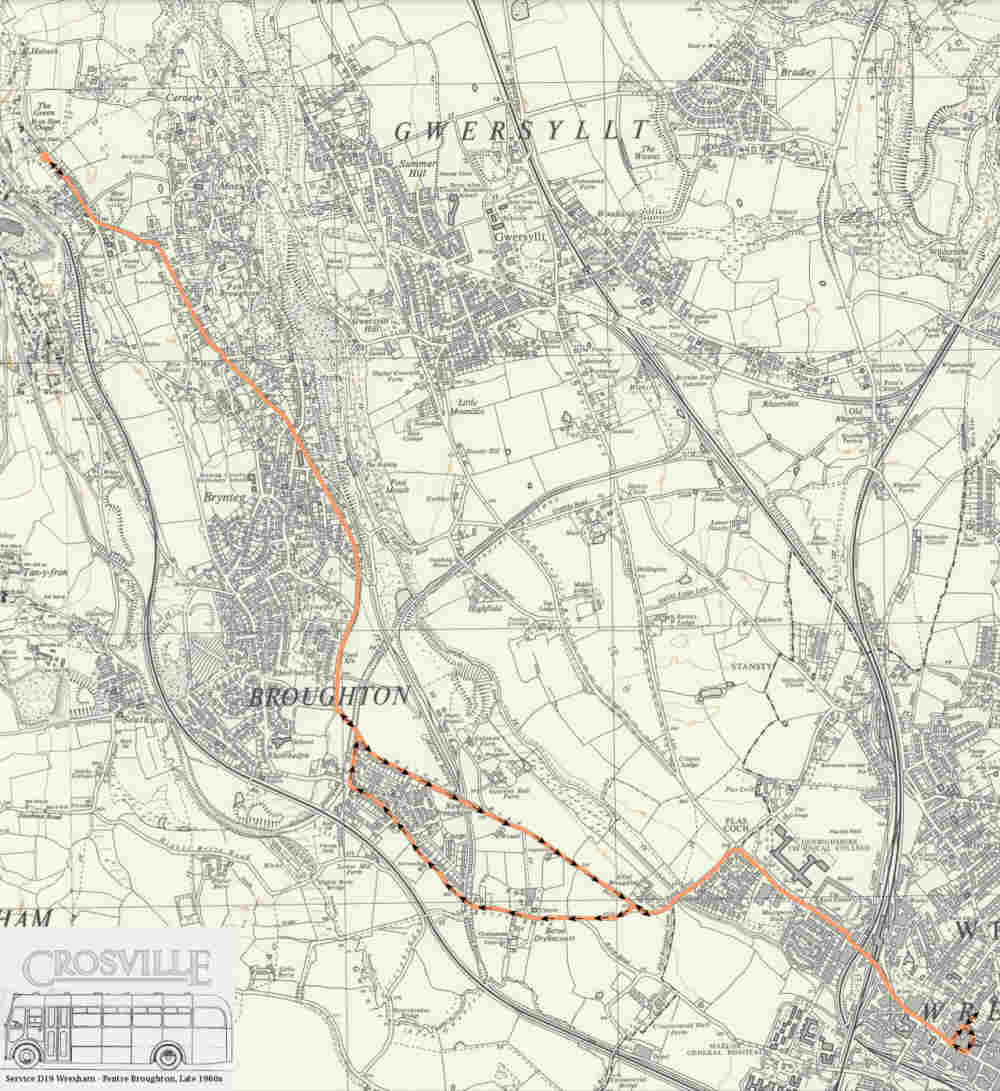
(The house I was born and brought up in was directly across the valley from Clayton Road, albeit at a straight-line distance of some half a mile, and it wasn't uncommon on still nights - especially with the bedroom window open - to hear the reversing horn of the bus as it manoeuvred itself into position for the inbound trip).
As I said, that inbound route had quite a substantial difference from the outbound one. Once down past Coed Efa, it would go past the end of Clubhouse/Dale Road and continue along Gatewen Road until it met up with Berse Road at Rhyd Broughton.
A real oddity about this route was that it was far more often than not served by double-decker buses. Why this should have been the case when Pentre Broughton wasn't a particularly big village population-wise and that both New Broughton and Brynteg (the latter of which the route skirted) were both adequately catered for by other services (in New Broughton's case, they also had the D11 Wrexham - Minera route passing through) is a matter fit only for conjecture at this remove of time. The sight of a large Bristol/ECW Lodekka chugging bravely up Hill Street must have been both inspiring and painful to observe (the view taken by the driver, conductor and passengers alike would, I suspect, be firmly in the latter category). However, the experience of being upstairs at the front on the return journey down 'The Castle' was exhilarating to the point of mild terror, and one which I partook of only once to the best of my recollection; as I said earlier, I would have to wait for more of that thrill until the Brymbo service started running that way some years later.
As with the D17, once that service started running there was no longer any need for a service designated for Pentre Broughton alone, especially with the D17 now covering the Gatewen Road/Coed Efa sections of the route, and the D19 was withdrawn. No more was I to hear the reversing horn across the valley at 2330 hrs. Pentre Broughton, like Brynteg, is now served by the 12/12A Brymbo services.
**********
Perhaps this is the most apposite place to talk for a moment about the vehicles themselves. Because Crosville at that time was part of a state-owned system, the company was made to standardise on one manufacturer (Bristol of, well, Bristol) and - for the most part - one coachbuilder (Eastern Coach Works of Lowestoft). Along with the livery styles - green for stage buses, cream and black for coaches and green and cream for vehicles which could be used for either purpose - this meant a certain uniformity in what we saw and what we rode on. This meant familiarity, but made for a certain lack of novelty, which was something we could only get when seeing the smaller local operators in and around the King Street bus station in Wrexham: the blue of Chaloner's of Moss, for example; or the red of Phillips' of Rhostyllen.
The Crosville buses which I first remember were the Bristol 'L'-types which were already well into their second decade of service, and would not last much longer. These were the last of the half-cab, rear-entrance single-deckers, and access was via a sliding door at the rear nearside quarter of the vehicle. There were a couple of side seats at the back of the saloon, but the remaining thirty or so seats faced front.
As time went on, the 'L's were replaced by Bristol SC4LKs which weren't that much newer than the 'L's, but which were used extensively on rural routes with small passenger demand or the need to negotiate narrow roads and steep hills (it was said of them that they could climb any gradient so long as you didn't mind waiting all day for them to do it). These were supplemented by Bristol MWs with a slightly larger seating capacity.
(It seemed to me that the D17 service in this period was always operated with MWs).
Change was to come with the introduction of the RE and its smaller sibling the LH. The REs were longer (with seating capacity up to 54 seats) and both models were narrower than most of what had come before. The sight of an RE swinging round a tight junction - say, the one from Park Road onto Tanyfron Road on the D13/14 - was not to missed if your tastes ran to sadism towards bus drivers.
Throughout this time, the double-decker fleet (which, as I've explained, we never saw up here anyway) was comprised entirely of variations on the theme of Lodekka, almost all of them of the rear-entrance-platform type. It was at the coming of one-man operation in the early 1970s that these old warhorses were phased out to be replaced by the front-entrance VR (in the same way that the SC4LKs were removed from regular work because, although the door was at the front, the driver had to swivel round about 140 degrees in his seat to work the ticket machine).
With the loosening up of purchasing options for National Bus Company fleets in the early 1970s, the dominance of the Bristol models began to fade, and Crosville bought a batch of rear-engined Seddon Pennine RUs (which proved to be notoriously unreliable), and then a large number of variants of the Leyland National, which were loud, rattly and - especially on the long D94 service, as I can testify from experience - uncomfortable. The Golden Days had clearly gone.
Update (09/09/21): By a happy chance, I have found a set of timetables for 1968 showing the routes I've covered in this piece (plus a D12 service from Wrexham to Coedpoeth and Penrhos - at the top end of Brymbo - which I didn't know about. You can see them here.
**********
(Click on the bus to go back to the blog item referring to this page.)
